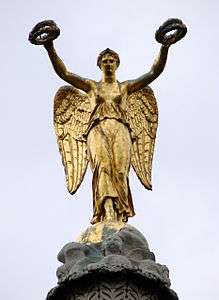Louis-Simon Boizot

Louis-Simon Boizot (1743–1809) was a French sculptor whose models for biscuit figures for Sèvres porcelain are better-known than his large-scale sculptures.
Biography


Boizot was the son of Antoine Boizot, a designer at the Gobelins manufacture of tapestry. At sixteen, he became a student at the Académie royale de peinture et de sculpture and worked in the atelier of the sculptor René-Michel Slodtz (1705–1764), with whom Houdon also trained. Boizot took the Prix de Rome for sculpture in 1762, for a sojourn at the French Academy in Rome (1765–70).
On his return to Paris he married Marguerite Virginie Guibert, daughter of the sculptor Honoré Guibert. He was admitted to the Académie royale de peinture et de sculpture in 1778 and exhibited at the annual salons until 1800. His portrait busts of Louis XVI and Joseph II, executed during the Emperor's visit to his sister Marie Antoinette, were executed in 1777 and reproduced in biscuit porcelain at Sèvres. A subtly nuanced decorative panel in very low relief, an allegory of Les Eléments, ca. 1783 is at the Getty Museum.
In 1787, a royal commission from the comte d’Angiviller director of the Bâtiments du Roi, for a series of heroic statues of illustrious French men for Versailles, resulted in Boizot's bust of Racine.[1] Boizot was one of the main artists whose work was included in the collection of the Comédie-Française at the end of the 18th century. Others were Jean-Baptiste d'Huez, Jean-Joseph Foucou, Augustin Pajou and Pierre-François Berruer.[2]

From 1773 to 1800 Boizot directed the sculpture workshop at Manufacture nationale de Sèvres, producing the series of white unglazed biscuit figures with a matte finish imitating marble, in which Neoclassicism was softened by a Rococo sweetness, or by a sentimental moralizing, such as in his hard-paste Sèvres porcelain group of a woman giving aid to a crouching woman with two children, allegorical of Charity, ca 1785, now at the Getty Museum.[3] Such figures were designed for chimneypieces or could be combined in a surtout de table. A vase produced at Sèvres, c 1787, in a classic amphora shape was known as a Vase Boizot[4] Boizot's connection with the piece is unclear: perhaps he provided the models for the gilt-bronze snakes that form handles.[5]
Boizot also produced terracotta models for gilt-bronze clock cases, such as the allegorical figures of the "Avignon" clock in the Wallace Collection, London, cast and chased by Pierre Gouthière, 1777,[6] and, exceptionally, for gilt-bronze furniture mounts on French royal furniture, where the meticulously kept accounts of the Garde-Meuble permit his role as modeller to be identified. Such a case is provided by the pair of draped female caryatid figures, balancing baskets on their heads and holding flowers and grapes in their laps applied to the corners of a drop-front secretary (secrétaire à abattant) that was produced under the direction of the sculptor and entrepreneur Jean Hauré for Louis XVI's Cabinet-Intérieur at Compiègne, 1786-87. Among a host of craftsmen (Guillaume Beneman stamped the carcase) Boizot received 144 livres for his terracotta model, "de stil antique". (Watson 1966, I, no. 107).

Boizot's models for seated reading and writing female figures, conventionally called L'Étude and La Philosophie (1780), originally destined to be executed in Sèvres biscuit porcelain,[7] were also copied in gilt-bronze by the ciseleur-doreur François Remond[8] and assembled as mantel clocks retailed by the marchand-mercier Dominique Daguerre. Three were purchased for Louis XVI at Saint-Cloud; examples are in numerous public collections.[9]

During the Revolution, he was a member of the Commission des Monuments in 1792. From 1805 he held a chair at the Academie des Beaux-Arts. He executed the sculpture for the Fontaine du Palmier erected in 1808 in the Place du Châtelet, Paris, in a more severe and bombastic Empire style. It celebrates Napoleon's return from Egypt. with a gilded Victory (finished in 1806) that surmounts a column with sphinxes spouting water at the base. The original of the Victory is in the gardens of the Musée Carnavalet.
References
- ↑ Now in the foyer of the Odéon, in the foyer of the l’Odéon,Place du Palais-Royal.
- ↑ Daufresne, Jean-Claude (2004-01-01). Théâtre de l'Odéon: architecture, décors, musée. Editions Mardaga. p. 151. ISBN 978-2-87009-873-8. Retrieved 2014-07-01.
- ↑ illustrated)
- ↑ An example is in the Royal Collection.
- ↑ The designation "Vase Boizot" was applied at Sèvres in the 1880s to an entirely different model .
- ↑ Wallace Collection F 258.
- ↑ An example of Boizot's L'Étude, seated in an oil lamp of antique form, Sèvres, marked for 1786.
- ↑ Remond's drawing after Boizot's model is in Remond's business archive.
- ↑ See Sotheby's New York,. 21 May 2004, lot 28. A pair, L'Étude and La Philosophie, in patinated and gilded bronze, ca 1786, at the Getty Museum, are said to be perhaps by Pierre-Philippe Thomire, nevertheless (illustrated).
| Wikimedia Commons has media related to Louis Boizot. |
Additional Reading
- L.S. Lami, Dictionnaire des sculpteurs de l'école française au dix-huitième siècle (Paris) 1910.
- Francis J.B. Watson, The Wrightsman Collection (Metropolitan Museum of Art), vol. I, no. 107 (the secrétaire à abattant), vol. II, p 563 (biography)
- (Getty Museum) Louis-Simon Boizot
External links
- Louis-Simon Boizot in American public collections, on the French Sculpture Census website
